#Natalia Bestemianova
Explore tagged Tumblr posts
Text
Natalia Bestemianova and Andrei Bukin Free Dance “Cabaret” 1987.
Cabaret by John Kander.
#i’m so glad these two weirdos were on top for so long.#ice dance#natalia bestemianova#andrei bukin#figure skating#cabaret#john kander#1987#1980s
122 notes
·
View notes
Text
Stepanova & Bukin: A Redemption Story
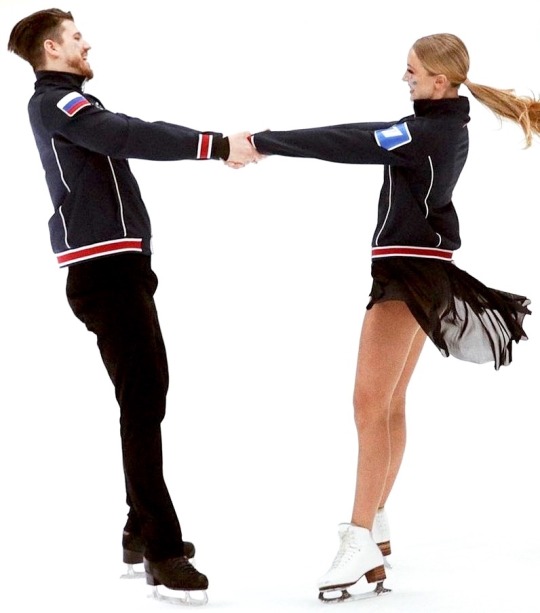
Irina Zhuk: A month before the 2018 Games, they already got their uniforms and were so happy.
Alexander Svinin: Irina and I were out for the Russian Junior Championships when we got a call from Moscow and heard the news.
Irina Zhuk: I don’t remember the next three hours cause to be honest, the only moment in my life worse than that was when my mom died.
Elena (Ivan’s Mom): Well, what a tragedy! I thought I was gonna have a heart attack. I was crying so hard... And then Andrei came back from the shop and said; “I already know. You have to stop crying. Vanya will be here soon. You should collect yourself!”

Ivan: When I found out that I was not allowed to participate in the 2018 Games, I was just in shock. It was hard to get over it. I was driving when I heard the news and I just stopped in the middle of the road. I asked: “How? What is the reason?” And the response was: “They didn’t say anything, they just sent a letter to the federation stating you are not allowed to go.” I was very upset and ashamed for my partner and coaches. I drove to the nearest gas station in shock and bought myself some water. The day was very sunny and warm, even though it was February. I stood and silently drank some water. The hours after that was very painful, endless calls from different people. It was a really tough time but we decided for ourselves to move forward, this is not the end of life.
Alexandra: I remember people saying: “Don’t be hard on Vanya for that, okay?” And I was like: “What’s wrong with you people?” Or they would ask: “So now you’re gonna dance with another partner, right?” And I thought: “Gosh, what the heck!”
Irina Zhuk: We were absolutely not ready for the rejection of Vanya. That day will remain a black day for us on the calendar. We have been coaching them for more than a decade. They are like children to us. Sasha’s behavior after learning of the situation definitely struck me. She turned out to be stronger than me on that day. It was more difficult for Vanya since his name was the one that appeared on the list. It was really sad to witness, considering what a positive person he is.

Natalia Bestemianova: You know, whatever happens, happens for the best. All this has strengthened them and it is why they have completely transformed into stronger spirits.
Alexandra: l think you should live through hard times to finally get what you deserve. I’m a really weird person! (laughs)
Andrei Bukin: They became more mature, they started to skate better, with more soul, with better technique, and I hope the judges notice that.
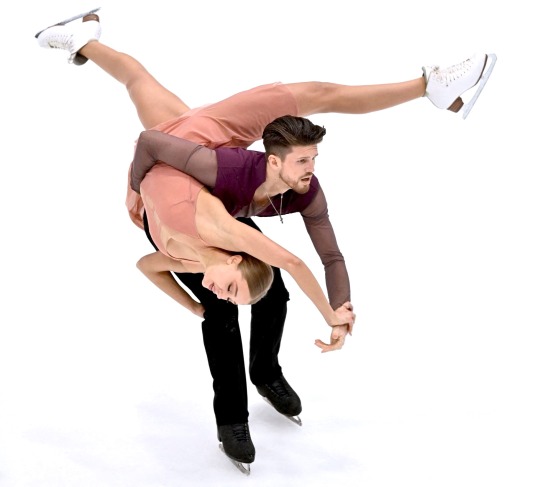
#THEM 🥺#GO BABIES GO ❤️#Stepanova Bukin#Alexandra Stepanova#Ivan Bukin#Andrei Bukin#Natalia Bestemianova#Bestemianova Bukin#Ice Dance#Figure Skating#Skating#Dance#Art#Sport#Athlete#Olympics#Beijing Olympics#Beijing 2022#Redemption#Story#Life#Love
61 notes
·
View notes
Text
Bestemianova attempting to defend Stepbuk and big them up in the media, saying nerves are what caused their issues today.
"Can you imagine how much they would have been given if not this mistake? tomorrow. They have a luxurious free dance, the best in the world, in my opinion, so let them skate, skating has not been canceled."
2 notes
·
View notes
Photo



When figure skating becomes figure running.
Top and bottom: Bestemianova & Bukin, 1985 Euros FD to Carmen Middle: Stolbova & Klimov, 2018 Euros FS to also Carmen
17 notes
·
View notes
Text
youtube
“The Gene of Victory” documentary on the Bukin dynasty is my favorite thing I’ve ever watched. Thank you so much @alexandravlad for the English subtitles.
You can see all my reactions and favorite lines here lol: https://twitter.com/yang_bo_dudnik/status/1097254854257369088
But I’m a really big Besti/Bukin stan (idk if everyone on tumblr knows but lol on twitter I tweet about Besti/Bukin Carmen all the time lmao). And everyone knows I stan Stepanova/Bukin too and love their programs this year.
youtube
youtube
Besti/Bukin Carmen is the first iconic Carmen in figure skating, one of the best Carmens on ice, and one of the best 6.0 ice dance programs ever.
youtube
Also they have my favorite rhumba compulsory. Look at that creative free leg movement on that XB-RFI to Wd-LFI! Look at that deep right back outside edge on the Wd-XF-LFI-Open Choctaw! Torvill/Dean’s flat right back outside edges are shaking! I’m actually serious about that lol. See T/D’s choctaw here rip: https://youtu.be/YGckC9Tl6yA?t=137 Both are flat, especially Jayne’s, but this is how a majority of rhumba compulsories looked since there were no key points and a lot of teams had trouble with the rhumba double choctaw. 😬

“This is more than friendship. It’s family” 😭 😭 😭
Anyways back to the documentary- Besti/Bukin really do have my favorite ice dance relationship and imo the ideal relationship for ice dance partners. They’ve known each other for 50 years, were never romantically involved, TAT said that unlike other teams she coached they didn’t have big arguments and always understood each other, they won OGM and 4 world titles together, they did professional skating and skated in Besti’s husband, Igor Bobrin’s, ice theater together, and they’re neighbors now!!!



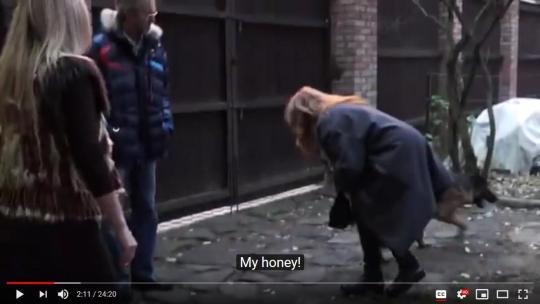
There was a period where Besti and Bukin were not in each other’s lives after they won the OGM. Besti refused tour offers and went to skate in Bobrin’s ice theater instead. Andrei tried to become a sports official, but it didn’t work out because he was pissed that the federation would take a lot of money, but wouldn’t use it to help poor athletes and he couldn’t stand telling for example poor boy who needs a costume for junior worlds that there wasn’t money for it. So he joined Bobrin theater as well and was reunited with Besti. They did many programs including those choreographed by Bobrin and also won 1991 World Professional Championships together. And of course they’re still neighbors! Besti visits Andrei and his wife, Elena Vasiuk, all the time, she plants bushes and roses for them, and she calls their dog Tina her honey! And of course she is like a mom to Sasha and Vanya and will literally do anything for them.
Now to the Stepanova/Bukin parts of the documentary:
I’m too lazy to post all the screencaps I already put on twitter again and also that would make the post super gigantic, but I’ll post the ones that also had cute pics here.

Vanya would say to young Vanya that he was a fool and that he needs to work, skate, study, and develop.

This is a super cute photo of Sasha and Vanya and lol the subtitle here is Elena (Vanya’s mom) talking about how it was a blessing that Sasha was always falling on jumps because it was clear she would take up ice dance and partner with Vanya after Vanya was dumped by Elena Ilinykh aksdalsjf
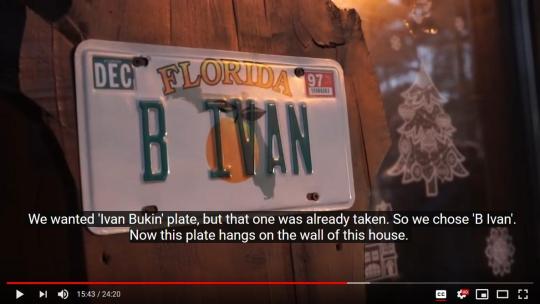
This is the license plate Andrei and Elena bought in Florida when Vanya was just 2.5 years old. They wanted Ivan Bukin plate, but it was taken so they got a B Ivan plate and have it hung on the wall of their house.
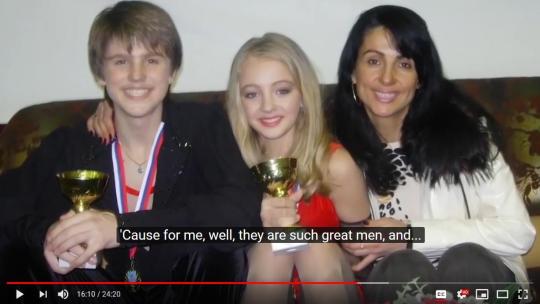
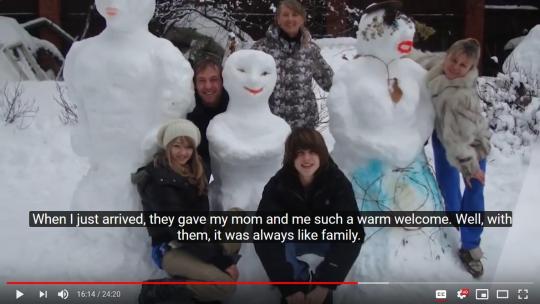

More cute pics from when Sasha was talking about how she was super shy when she and her mom moved in with the Bukins, but they gave them such a warm welcome and it was always like a family.
Also I found this part to be super relevant, so here’s everyone talking about Vanya not getting invited to the Olympics 😭 😭 😭
Their coaches Alexander Svinin and Irina Zhuk:
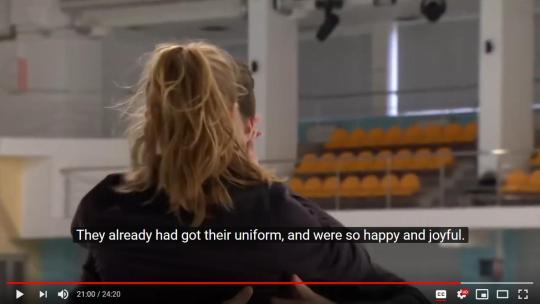
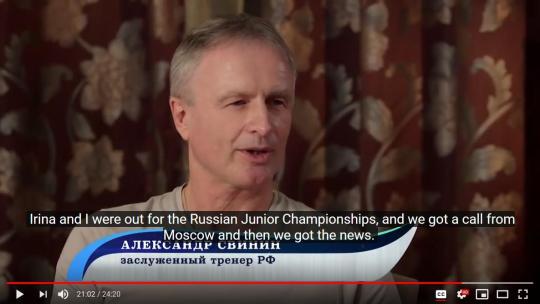

Vanya’s mom, Elena Vasiuk:
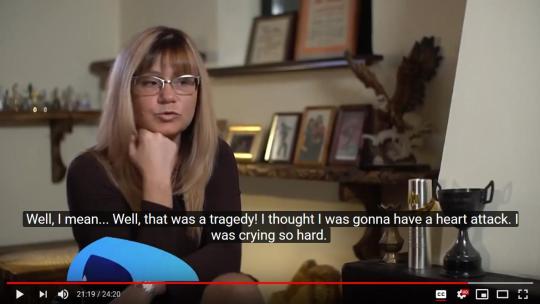

Vanya:


Sasha (Also smmmmmmhhhhhh at people who tried to get Sasha to dump Vanya as a partner):

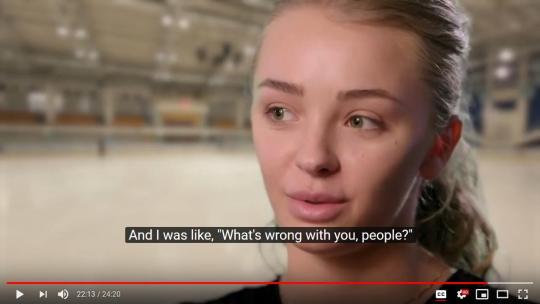


Besti and Sasha:




And we end with “the history of the sport dynasty of Bukins is like a fairytale 😭 😭 😭

#alexandra stepanova#ivan bukin#natalia bestemianova#andrei bukin#figure skating#fs#fskate#ice skating#ice dance#ice dancing
71 notes
·
View notes
Note
Do you happen to know what daniil said about alina during the euros gala i've seen people thank him for standing up for her but i have no idea what he actually said since i don't understand russian :( but i really want to know. I'm sorry this is a weird ask
“I want to reach out to all the figure skating fans. It is a difficult time for us. Not everything is going well, but don’t we all want our Olympic champion to keep delighting us with her skating for more than one year? I don’t understand why some specialists and experts escalate the situation, instead of simply being supportive, making unreasonable and I would even say cruel criticisms. Let’s be kinder to all our athletes and everything will work out.”
Thanks for the ask, anon.
#you just know who the 'specialists' are#natalia bestemianova#tatiana tarasova#the usual suspects#figure skating#alina zagitova#daniil gleichengauz#europeans 2019#ask
27 notes
·
View notes
Photo

@rogonov_alex Провели свои контрольные прокаты в школе Натальи Бестемьяновой и Андрея Букина на новом катке в Домодедово. Спасибо за уникальную возможность обкатать программы!
#alexei rogonov#Kristina Astakhova#anastasia shpilevaya#grigory smirnov#artur dmitriev jr#Ivan Bukin#Alexandra Stepanova#natalia bestemianova#andrei bukin
6 notes
·
View notes
Note
Hi, I’ve been watching ice dancing events over the weekend, and I have to say not very inspired by any of the dances :(
But my question is this: is it a new fashion in recent years for women to do spread eagles with bent knees? Or is it that I just noticed it now? it seams in almost every single FD or/and RD done by majority of teams.. and to tell you the truth it just looks vulgar in dance, cannot see any elegance in that whatsoever.. maybe it’s just me and I’m getting old.. but somehow that particular move started bothering me over the last few seasons and it’s everywhere! I understand it in singles and in pairs, but somehow in ice dance it just out of place..or maybe another reason is that dancers just cannot incorporate it nicely 🤔
It’s not actually a question, sorry! Just some ramblings clearly..
Hey, anon!
Just want to clarify, I think it sounds like you are talking about besti squats, which is actually a particular move and is named, funnily enough, after the ice dancer Natalia Bestemianova; she did it about a million times in a program with her partner Andrei Bukin (father of Ivan Bukin) back in the 80’s.
It’s a spread eagle just with very bent knees, like you said:

I also don’t think besti squats are super cute in any of the disciplines in general, it’s one of my least favourite moves in figure skating, for sure.
I, too, have no idea how figure skaters think a transition like this:
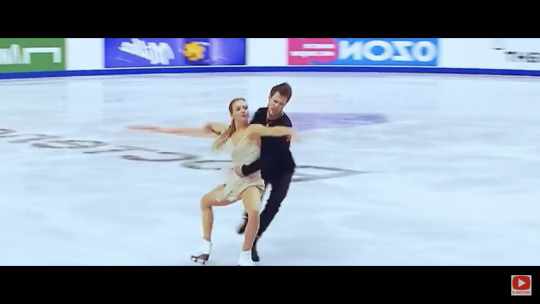
…is at all aesthetically pleasing.
#it just looks like you’re peeing#“let’s be real#it looks like you’re full having a wiz#konner talks skating#if this isn’t what you’re talking about lemme know#😇😂✌️
6 notes
·
View notes
Text
Otoñal by Raúl di Blasio. Ice watercolor of Yuzuru Hanyu.
Yuzuru Hanyu’s 2018/2019 season SP analysis by Yulena translation. Source: pt1, pt2.
“The origins of my skating come from Russia. For that reason, I want very much to deliver a strong performance here. Both tomorrow’s and today’s programs have a connection to Russia. [Tatiana] Tarasova helped to choreograph the original “Otoñal” program. I am very grateful to the person who created the choreography and watched me standing, and also [Natalia] Bestemianova and [Igor] Bobrin, who had helped me with choreography for the “Romeo and Juliet” program. I am overwhelmed with emotions just because such people have awarded me with standing ovation. I saw Tarasova as I approached the jump, and Bobrin was in the guest seat of the arena clapping on his feet. Thank you very much” ©
– interview after the SP at Rostelecom Cup 2018
Musical arrangement of the 2018/2019 season’s short program for two-time Olympic champion Yuzuru Hanyu is one of the piano piece by Raúl Di Blasio. Both of his programs this season go back to his origins and the starting point of Yuzuru’s career, to his childhood dreams. They are also an immense tribute to the skaters he’s considered his idols since his early days - Johnny Weir and Evgeni Plushenko.
According to Yuzuru’s own words Johnny Weir’s “Otoñal” is one of the programs that left the greatest impressions on him in his skating life.
“The arm positions during spins, the softness of expressions, the way to pick up nuances and move to music, landing positions and so on, it was the music of the programme that led me to perform with attention to each of these details.”
– Public practice in Toronto, 30.08.2018
Having seen Johnny’s performance as a child Yuzuru listened to this music while imitating his idol and dreamed of creating his own program.
“I was stunned by his neutral androgynous beauty that he as a man could present, that was his main charm. At that time, I couldn’t see and evaluate jumps by GOE right away, but the smoothness on the landings, beautiful positions on the exits, precision of jumps placement to the music – all that was made meticulously. First of all the landing. And that smoothness. Of course, all those things captured my attention. I clearly remember how I wanted to jump and skate just like that.”
– Public practice in Toronto, 30.08.2018
The choreographer for the new short program once again was Jeffrey Buttle. From Brian Orsers’ book “Team Brian”:
"Yuzuru has incredible creative chemistry with Jeffrey Buttle and Shae-Lynn Bourne. You may say that it eould be hard for him to work with anyone other than those two. Yuzuru has his own jump entries that fit the way he moves, and comfortable timing of choreography is very important for him. Even his quads flow out of steps, he keeps an image of the perfect form in terms if speed, that step and curve angle in his head. He needs a choreographer who could share his attention to details, so unique for the skater of his level.”
When Jeffrey learnt the name of the composition he first of all ask about Yuzuru’s associations with the music. He answered: “Something like reflection.” “Otoñal” means “autumnal” in Spanish. Autumn as a memory from the past and reflection on the passing time, dreams and origins. That was the chosen theme for the choreography of the program, from the starting to final poses.
“And for him, Autumn is sort of a time of the year for reflection and about looking back. Almost a time of nostalgia? And I think it was so appropriate given what he accomplished and everything that happened last year. Choreography itself begins with… for me when I think of nostalgia, I think of looking through an old family photo album, so the very first movement is him opening that album.”
– Jeffrey Buttle, interview after Public practice in Toronto 30.08.2018
The main idea of the composition lies in the travel in time and calling (обращении к ) to the personal story in figure skating. In the starting pose according to the Jeffrey’s idea Yuzuru opens the album with memories of the past. And so the skating choreography, musical and compositional structures of the program, distribution of the elements all go back to the origins and show great respect to the people that had influenced Yuzuru’s path.
The content of the program includes two quad jumps, one executed in the combinayion wioth the triple toe loop and a triple axel: 4S, 3A // 4T+3T, FCSp, CSSp, StSq, CCoSp.
The choreographic structure (composition) of the program was evolving during the first three competitions of the season.
1. The structure of the program has been changed that stood out as uncommon and unusuala and uncharacteristic for Yuzuru positioning of all the jumping passes back-to-back in the single block. That was a decision taken by Yuzuru and Jeffrey together because that distribution would allow to incorporate jumping and not-jumping elements (step sequence and spins) most harmonically in the musical structure. The jumps from the entry to the exit are executed one after another (bam-bam-bam ©), then comes a soft musical transition to two spins and the emotional explosion of the step sequence at the end of the program. “[...] Stillness versus the tempestuousness of the steps.” ©
In the first half of the program with gentle subtle music the jumps are done effortlessly softly and smoothly, when the emotions are expressed with the second half via the spins and sequence.
Originally the center element of the program – 4T+3T combination – was planned in the first half. But “it is all meaningless unless it allows to win.” © So after the very first competition of the season (ACI 2018) sports competitiveness and desire to win took over, and the combination was moved to the second half of the program.
This change brought corrections to the original choreography and composition: the entry to the 4S became more complex, the transition between two spins and sequence changed, and new skating transitions were added between the 3A and the 4T+3T entry. Before the Rostelecom Cup 2018 the entry to the triple axel also changed and new transitions between triple axel and combo were added once again.
Despite the move of the combo to the second half the jumping passes remained in one block that the most intricate skating choreography in between the elements and on the entries/exits mode possible. The notorious strategy of Yuzuru is based on the idea that the jumps are one of the performance parts. If they are done perfectly the program gains better fluidity and continuity of the movement from one element to another, and seems complete. More than that, Yuzuru is set to present the program in such a manner that the sound of the take-off and the landing themselves would enhance the выразительность of the quite musical intonations.
“Also, the sound — shu! —of the edge when taking off, the sound — pa! — of the landing. I want to make [this program] such that even these sounds can be felt, as a part of the expression.”
– interview for Figure Skating Life vol 15 (10.10.2018)
2. Positions of the jumps and spins changed in the pattern of the program, with the latter becoming more multidimentional. The quad salchow (together with the trajectory of the entry) have been moved to the right part of the rink. Compared to the previous short program (Chopin Ballade №1) the triple axel and the combination placement changed. Th eboloved axel now is executed on the trajectory along the long board of the judging panel with additional chic, the combo went from right to the left side from the judges’ perspective. The camel spin went to the left side, the sit spin with the change of foot – very close to the left short board, and the final spin – to the center of the ice rink.
3. Due to the placement changes after the ACI there also came the changes in the structure of the step sequence, it became shorted by 4s and the complicated steps and turns counting to the levels of difficulty became more “packed” together.
4. Some of the difficult variations of the basic positions in the sit spin and the combination spin counting to the levels of the corresponding spins were changed. With that the variations are not just executed to earn the levels but also to choreographically enhance the interpretation of the music with precise and flashy accents with hands movements. The distinguishing qualities of Yuzuru’s programs is the prevailing skating choreography as the principal mean of interpretation; the continuous flow with various connecting elements and steps contributes to the wholeness and creates multiple dimension to the composition. This is accompanied with the special choreography of diverse upper body and arm movements. And the unity of both the skating transitions and the space choreography throughout the program makes the unity of the music and the skater’s performance stand out. It expresses the intonations and reflects the changes oh the tempo and the nuances of the phrasing. .
With the changes of the composition after the first competition came the changes of the arrangement of the music.
Right after the ACI 2018 Yuzu contacted sound producer Keiji Yano asking him to make corrections to Otoñal for the purpose of moving the combo. It is a known story that Yano-san has rearranged the track for SEIMEI more than 30 times following Yuzuru’s requests. This time he also confessed: “His orders were precise as usual. This time too, [his instructions] were detailed, as always. It was a test of my skills.” At the beginning of October Yuzuru received the new arrangement and started to training according to it.
Musical structure of the program and its collaboration with the composition:
Intro
(from the starting pose to the beginning of the combo entry (transitions – entry – 4S - exit – transitions – entry – 3A – exit – transitions).
The program starts with some low piano harmonies turning into gentle and quite intonations at the beginning of the new phrase. This transition is choreographically translated with Ina Bauer and highlighted by the smooth lines and movements of the skater. This part is based upon two melodic phrases (like nostalgia and look back into the past).
Development
(transitions – entry – 4T+3T – exit – FCSp – transitions – CSSp)
Transition between two musical parts is highlighted with a series of twizzles. The combo entry coincides with separated abrupt low accords. Emotional tone and intensity grow stronger throughout the whole entry and reach the highest point at the moment of combination with both jumps landed on the beats. The transition from exit to the camel spin separates the two musical phrases. The new one has a contrast of intonations. And the momentary transition evokes images of the grim autumn sky with simmering clouds suddenly broken by a ray of sunshine, of nature coming alive under this warm light. But surely “everyone will see something different” ©. The phrase ends with another set of low accords at the transition to the sit spin with change of foot.
Culmination
(StSq - CCoSp)
This is the most passionate and emotional musical part with strings introduction at the beginning of the StSq. The dynamism of the music increases and results in more energy and expanded scope of the movements during the step sequence execution. At the end of the sequence the strings die out and the final combination spin is set to the piano part that has a smooth transition to the ending pose and concludes the program in a beautiful way. All three music parts are intricately tied with the choreographic structure and create an integral image of the program, in which the music is not born by the fingertips on the piano keys but comes to life with the blades touch on the ice. Each musical phrase is accompanied with amazingly arranged choreographic accents.
The elements and skating transitions connection to the musical phrases comes as follows:
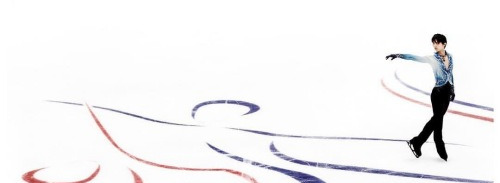
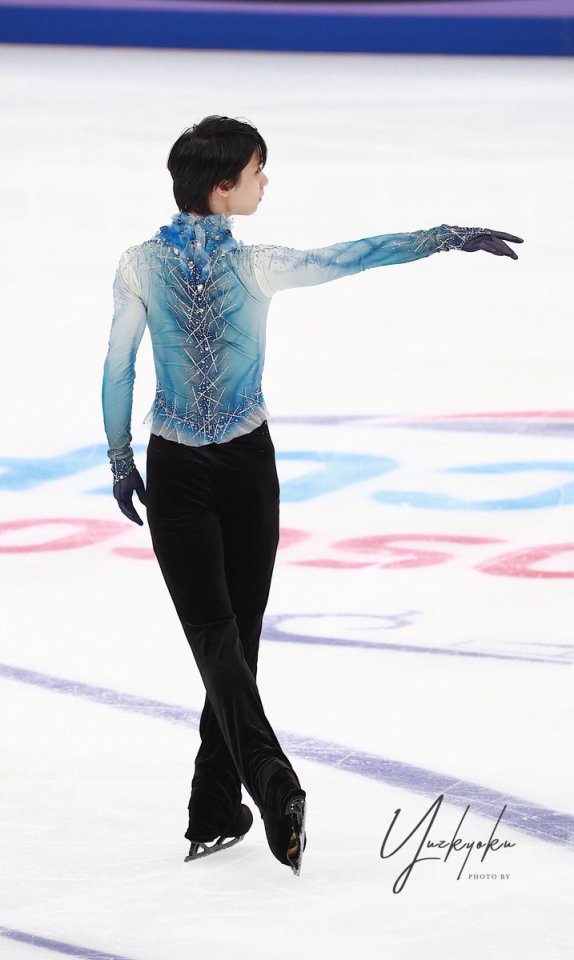
The starting pose with elegant turn of head to the side of extended arm as the call to the past and reminiscence of the bygone days.
The begining of the program consists of melody in five low separeted harmonies with piano accords. There is a turn on the first accord and a movement of both arms on the second harmony in the posing.
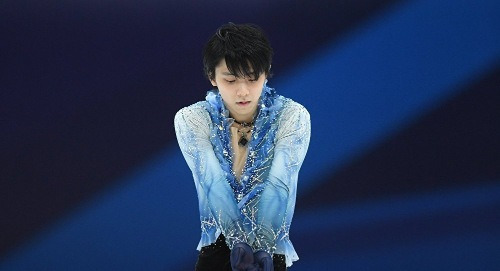
A LFO waltz three turn with accentuated lobe of the exit and a crossed step RBI/LBO on the beat (third accord), direction change forward, running step, chasse LFI/RFO and direction change right on the note (forth accord), lingering and accentuated crossover and two more crossovers on the final fifth harmony. Delicate and slightly reversed choreography of this part is connected to the laconism of the musical phrase. Then Yuzuru softly stands in the Ina Bauer (with elegant arms movement) that unites the first part to the second and also marks the beginning the solo 4S entry: accentuated waltz three turn LFO at the start of the phrase – backward power three turn RBO – inside spread eagle – RBO backward power three turn – 4S.
The element in the while fit the music phrase and in its length: a difficult entry to the jump, an exit after the landing and skating transitions right after are all executed in three measures of the musical phrase. The first measure starts with the entry steps and ends with soft and almost silent landing; the exit into counter - Ina Bauer for the second measure; skating transitions after the exit of the jump fit the third and final measure. Holding closer to the notes ©
The difficult exit from the landing lobe to the RBO counter (such exit from the quadruple jump in the only one in the field of men singles) with smooth transition into the inside Ina Bauer. Then comes direction change forward, LFO three-turn, LBI/RBI broad step with both arms movement on accent at the end of the measure. Softness of the piano sounds during transition to the Bauer is choreographically enhanced with graceful turn of the head and arms going down smoothly.

The accentuated crossover (with prolonged exit lobe), crossover, RBI/LBO chasse and to the fading sounds of the music Yuzuru goes into the outside spread eagle. This long SE set is executed with emphasis on the soft movement up of the head and the right arm that highlight the laconism and gentleness of barely audible sound on the verge of two musical phrases.
“He can make the most pregnant pause nothing moment be so memorable [...]”
– David Wilson, Japan TImes 21.08.2018
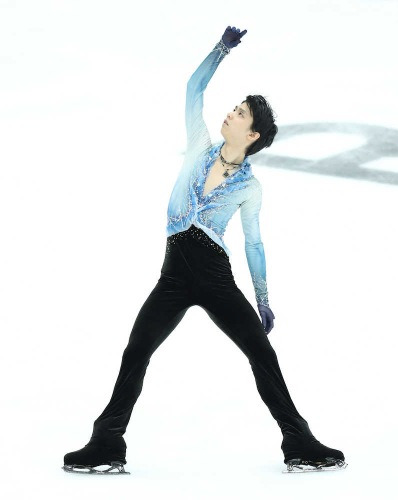
The beginning of the new musical phrase is marked with elegant change of edge in the spread eagle with arms softly going up on the note. The following skating transitions, difficult entry to the triple axel, the jump itself and the difficult entry are all in harmony with the musical structure: LBI/RBO chasse and accentuated RBO choctaw, change of foot, RFO/RFI change of edge, RFI swing mohawk, accentuated LBI/RBO chasse with right arm soft moving as if touching the piano keys and a crossover at the end of the measure.
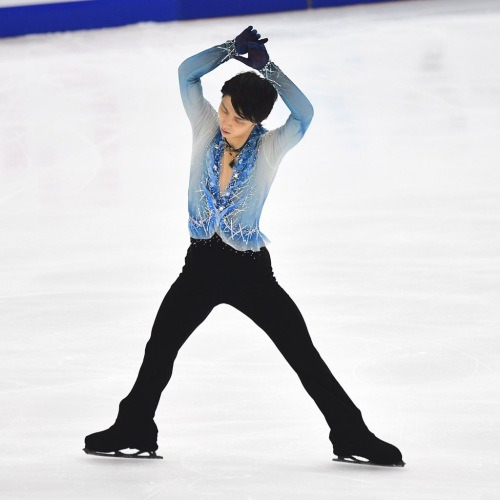

The entry to the 3A fits the second measure of the phrase: RBO choctaw – RBO/LBI crossed step – LBI/LBO change of edge – LBO/RBI crossed step – LBO counter at the end. The jump has a difficult exit on the lobe of exit – RBO twizzle – RFI three-turn – mini-Bauer – that fits the extension of the musical rhyme. Holding closer to the notes ©
His triple axel is not just a jump. It’s art. An element perfectly integrated in the choreographic pattern of the program and presented as organic ending of the skating on the entry and natural premise to the skating on the exit. It is remarkable that the skating transition after the landing is executed in two motions with inartificial pause (on the three-turn between a twizzle and a Bauer) at the end of the phrase to the fading music. Such an absolute harmony in movements is hard to put into words. It is complete fusion with the music, when the rhyme of the steps and turns on the entry/exit and the jump itself matche the music beats.
“Hanyu’s triple axel is a jump of an outstanding beauty with natural and effortless timing.” © Elvis Stojko
The exit of the triple axel precedes a transition of steps and turns musically inserted in the additional measure: crossover, LBO choctaw, accentuated RFI bracket, RBO/RBI change of edge, RBI/LBI broad step going into posing, crossover. Smoothness of this transition execution set to the final musical phrase of the first part demonstrates excellent interplay of movements and blade and the music.
The second part starts with musical phrase of changing intonation that is choreographically expressed with a series of twizzles and skating transition: crossover with accentuates arm movements – LBO choctaw - crossover -Jackson (composition step). Musical tone changes with increase in intensity and accentuated piano accords coming in at the start of combination jump entry, the change marked with arms movement. Skating transitions on the entry are following the increasing dynamics and executed in accordance with such. The combination itself takes a special place in the composition of the program; it highlights the intonations of the phrase precisely. Holding closer to the notes. ©
Direction change forward – LFO three-turn with great flow and body and free leg move on the exit – inside besti squat – crossover with direction change forward – LFO counter - LBO/RBI crossed step – direction change forward – LFO three-turn – 4T+3T.
“He studied all the phases of the jumps in every detail and does them in one breath.” © Kurt Browning
This combination was executed [at Rostelecom Cup 2018] just ten meters away from me and was truly impressive, both light and powerful, fitting the general mood of the program. Yuzuru flied by the boards in a whirlwind and practically slammed a spread eagle on the exit in to the ice as if in a statement: “I’m Yuzuru Hanyu, I’m strong, I’m confident, and I crave for victory.”

A direction change forward and a FCSp entry are executed to the change of musical intonation at the start of the new phrase. This new musical theme is choreographically presented with a block of two spins and a skating transition in between. This is the most graceful and the airiest part of the program especially contrasting with the combination jump. Light and elegant touch of color in the music watercolors…
Features of difficulty of the spin:
Difficult entry (arabian)
Difficult camel variation (upper);
Difficult variation of the sideway camel spin (catchfoot) «ring»;
8 turns without a change of position («ring»)
The difficult variation of the basic position execution is perfect.

The spin is wonderfully fit the musical structure of the program: – the Arabian jump on the entry highlights the change of phrases and intonations; – the landing of the Arabian is placed right on the start of the beginning of the new phrase; – the change to the difficult variation of the camel spin “ring” at the start of the second mesure and the execution of the variation in two measures; – exit from the spin highlight the start of the next measure.
Intricate hands gestures in the difficult variation positions throughout the spin enhance the musical accents: – arms being raising and fists clenched at the end with subsequent arms movement down with palms unclenched to the accent at the end of the measure; – undulating soft up and down movement of the left arm in the “ring” position with hand reaching out at last right to the accent; – almost indistinguishable gentle movement of the left hand then elegantly going down that highlights the beginning of the next measure.
The end of this measure has very musical exit out of the spin with smooth and soft movements of both arms and head. Skating transition before the sit spin with change of foot fits in the next measure: exquisite bracket step going into lightest toe steps with direction change and half-dropped arms – as if running through the piano keys © This stunningly musical and delicate transition between the spins is one of my personal favorite moments of the program.
The sit spin with change of foot (CSSp) execution enhances the change of mood and highlights built-up of the emotional intensity as the culmination draws closer. Features of difficulty:
difficult entry - “windmill” (illusion spin);
jump in the spin without change of foot (flying sit spin);
change of foot (from right to left);
difficult variation of the sit spin (sit sideways);
difficult variation (sit behind).
The maximum number of features of difficulty the sit with change of foot can receive for spinning on one foot equals two. This condition is fulfilled: two positions are executed on the right foot and another two – on the left. Thus the spin receives level 4. The spin is excellently inserted in the musical canvas of the program, the execution growing more dynamic in accordance with the music changing: – difficult entry to the spin is executed right on the start of the piano passage accompanied with low piano accords at the end of the second part; – “spinning” into the basic sit position on the passage; – accentuated jump in the spin and the change of foot;
Melodic accents in the spin come with arms and hands movements in difficult variations of the basic positions and precise choreographic features: – touch of both hands to the face in the basic sit spin position on the note; – accentuated right hand touch to the cheek in the difficult body position of the “sit sideways” variation that influences the balance; – right hand movement on the resounding low accord during the difficult variation “sit backwards”.
Yuzuru completely controlled all the space of the Megasport Arena. And the audience seemed to feel that as one, and responded with thunderous applause on the last two positions of the spin. Yuzuru wasn’t skating the program, he was telling his story. It seemed that music was emerging from the blades meeting the ice and his hands moving softly, as Yuzuru dissolved in the performance. During the program mood changed from quiet melancholy of the first half to passions raging on the combination jumps and then to the overwhelming happiness of the step sequence. How proudly did Yuzuru toss his head bursting into the sequence with a radiant smile! He skated like there was no tomorrow, giving his all to this performance, and involuntary tears came streaming down my cheeks. Ow happy, inspired and free he was at that moment! I haven’t seen enough of that ©
The Step Sequence
Toe steps L/R/LFI, broad step LFI/RFI, twizzle RFI ccw (2 turns), three-turn RFI ccw, turning choreographic movement (steps) of 720 degrees ccw, chasse LBI/RBO, choctaw RBO ccw, choctaw LFI cw, half flip cw, mohawk LFI cw, twizzle RBI cw (2 turns), half flip RFI cw, mohawk LFI, twizzle RBI cw (2 turns) - rocker RBI cw - counter RFI cw - crossed step RBO/LBI, change of edge LBI/LBO, crossed step RBO/LBI, change of edge LBI/LBO, choctaw LBO cw, broad step RFI/LFI, mohawk LFI cw, hydroblade (right on the final of the musical phrase), one-foot axel (in which Yuzuru basically flies up at the beginning of the new musical phrase), chasse LBI/RBO, mohawk RBO, crossed step LFO/RFI, bracket RFI cw, cross roll RBO/LBO, lobe LBO with free leg swing, loop RBI cw, falling leaf cw, bracket LFI ccw, crossed step LBO/RBI, direction change forward, rocker LFO ccw – counter LBO ccw – loop LFO ccw.


Scheme of the Step Sequence
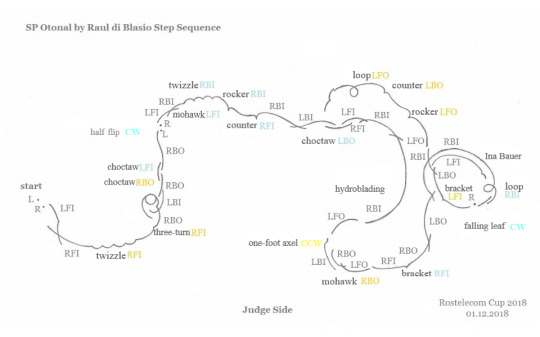
Table of difficult turns and steps of the StSq:

Features of difficulty of the StSq:
Following turns and steps are cunted towards the features: two clean choctaws (cw and ccw), two rockers (cw and ccw) two counters (cw and ccw), two brackets (cw and ccw), two twizzles (cw and ccw), two loops (cw and ccw). All in all 12 difficult steps and turns.
All 6 types of difficult steps and turns are executes in both directions (clock-wise and counter clock-wise), that satisfies complexity criteria, maximum level of the StSq is 4.
Rotations in either direction (left and right) with full body rotation covering at least 1/3 of the pattern in total for each rotational direction (see scheme). Feature counted.
Use of body movements for at least 1/3 of the pattern (arms, head, thighs and upper body work is definitely enough). Feature counted.
Two different combinations of 3 difficult turns on different feet (first on the right, second on the left). Both are executed with a clear rhyme within the sequence. Feature counted.
Thus all four features are counted towards 4 level of difficulty.
The element as a whole is wonderfully implemented in the musical canvas. The timing and scale of elements (e.g. hydroblade, one-foot axel, Ina Bauer) compliment the rhyme and beats. Every step and elements also enhance the precision of interpretation and highlight the phrasing. The same can be stated about the choreographic accents during the execution that fit the rhythmic pattern: steps and turns at the start and the combination of hydroblade and one-foot axel executed on the change of phrases, the second combination of three difficult turns that coincides with the end of the phrase, the change of foot right after the final loop at the end of the measure and distinguishing the end of the sequence. Movements suit the mood and style of the music and also become a mean of interpretation. The final combination spin CCoSp is entered through the “traveling came” at the beginning of the new musical phrase to highlight wave-like changing intonations of the final part. Features of difficulty of the spin: Camel spin
change of edge in the camel spin from inside to the outside;
difficult non-basic position;
Change of foot (from left to right)
difficult variation of the sit spin (sit forward “a-la Johnny”)
difficult variation of the upright spin (“scratch spin”).
In the combination spin all the three basic positions are executed: camel, sit and upright. Four difficulty features are used. For the combination spin with change of foot the maximum number of features attainable equals two for each foot. This requirement is fulfilled (two position on the left foot, two – on the right). Thus the spin is level 4.
Change of positions in the spin on the left foot by the measures: – change of edge in camel spin – transition to non-basic position – change of foot and transition to the difficult variation of the sit spin on the beat – difficult variation “scratch” of the upright spin on the fading of the melody at the end. Choreography is accompanied with the intricate hands and arms movements in the spin to even further express the musical accents:
– accentuated choreo during the camel spin: – undulating hands movements in the “pancake” position; – gentle left hand gesture in the upright spin.
Transition to the final pose that mirrors the starting one, symbolizes the flow of time. The only fascinating difference: in the starting pose Yuzuru turns his head in different direction. His eyes seem to be fixed on the future, on new hopes and dreams. Everything continues to…

Johnny Weir, interview for Number 966, 22.11.2018:
“Yuzuru used some elements of my program that looked very harmonic. At the same time the program became something personal for Yuzuru, he skated it in his own style, that touched me very much.Yuzuru did everything in order to fully express the music. And if I showed it as soft and gentle sadness, Yuzuru demonstrated his fierceness and the brilliance of the composition. Music just as people is versatile, and Yuzuru and I showed different interpretation sides of the same melody. His talent became obvious even in his childhood day, but he have grown up to be the athlete I couldn’t even imagine. Yuzuru became so unbelievably strong, and despite the injury conquered his second Olympic title. I never thought I would live to a skater so strong. To everyone who doesn’t know him personally I can say that after all this time his compassion for people and his humanity haven’t changed in the slightest. He’s famous all around the world, and yet his modesty and approach to people remain the same as they were on the day I’d met him for the first time.”

Translator’s notes:
* the original article was published in order to celebrate Yuzuru’s 24th birthday, as was this translation, belated as it is. Hope you’ll be just as happy as you deserve for inspiring so many people all over the world with your skating, your talent and your heart, Yuzuru!
** some quotes were unfortunatelly translated from Russian (credits to Аnna Zamotayeva and Evgenia Mitrofanova) where the original wasn’t available. Considering that some quotes went from English to Japanese to Russian to English, nuances may be lost in translation. If you have sources with original (either Japanese or English) quotes, I would be happy to improve the text. *** if you have any questions or suggestions concerning technical skating details, chances are I messed up in the translation, and it was not a problem of the original, so please, contact me first. Also, none of the photos belong to me, and if you would want your picture taken down, I would do so right away. Thank you!
300 notes
·
View notes
Text
What THE HELL !??!
Right now the Russian FS Community is such a hell.
There're thousands headlines about how poor is Evgenia losing all the shits, and dont deserve it 'cause she is the best(someone even call her Saint).
And on the top of that Natalia Bestemianova who said "If Medvedeva was stayed with Eteri then Zagitova wouldn't be so good. Eteri tolerate her, only out of spite on Medvedeva."
FS fans just shocked!
ONLY Alexei Yagudin stood up for her! This is from Yags IG

"What a mess! How you even can think like that? Just leave girls alone!"
Can you believe in this? ONLY 1 person from community stood up for her!
I bet it is a fucking bullying to make Alina emotionally weak for GP final. 'Cause they are so jealous for Eteri team's gold medals.
#figure skating#team russia#alina zagitova#evgenia medvedeva#alexei yagudin#all the community are crybabies#except yags#yags is the best#i'm not sure in my english#sorry for mistakes
45 notes
·
View notes
Text


30 notes
·
View notes
Text
Boikova & Kozlovskii: Gaining The Momentum

The youngest pair to stand on the European podium since the legendary Gordeeva/Grinkov, Aleksandra and Dmitrii are now finishing their third full season as a team.
Is it true that it was your decision to partner up?
Dmitrii: Yes, it is true, more or less. I had a different partner, but you can say that at that time, I was mostly skating by myself... And when Sasha came to our rink for tryouts, I immediately noticed her and said that I want to skate only with her.
Aleksandra: We’ve known each other since childhood, and we trained in the same group as single skaters when we were little.
Dmitrii: We skated together in Alexei Mishin's group and our development was alongside each other. It is still a bit surprising that we formed a pair. Five or six years ago, if someone told me this, I would have said: "Are you crazy?"
This is your third full season together. There is a common opinion that pairs needs at least three years to really become a pair. Do you agree with that?
Dmitrii: I think we're heading in this direction. Little by little, we're becoming a pair, starting to feel small things, fine details about each other. Indeed it takes time. You don't get this in a month. But it varies - for some, this might take one year, and for some, this might take ten years. I can tell that we're at this stage where we have deeper communication between us.

You're considered to be a rather tall pair, which pros and cons do you see in it?
Dmitrii: I don't see any downside at all. Actually our height is optimal, we're neither too tall nor too short. We have a good presence on the ice, and we have high throws and twists, so I can't name any disadvantages. We have good control over our bodies and so our height is comfortable for us.
Do you plan to raise the technical difficulty of your programs? In previous seasons, you showed a throw triple flip, you also had triple-euler-triple combination, tano double jumps. Are any of those coming back?
Aleksandra: Our main goal for this season was to skate clean. We only reduced our technical content because we wanted to show better quality and more confidence. Of course, we plan to work on higher-level elements including triple-triple or triple-euler-triple combinations.
The triples are going to be toe loops?
Aleksandra: We will see. There are a few options. We trust our coaches to help us in this. We will also work on throws. Unfortunately, throw triple flip which was compulsory for us in juniors last season, did not always work... But when we succeeded, it was indeed impressive and scored positive GOE. So we definitely plan to work on these elements and improve our technical content.
Dmitrii: This season we made an emphasis on our skating skills and interpretation. As the rules were changed, mistakes are now much more costly... You can lose ten points on one mistake. Nowadays in pair skating, you almost never know how the program will go. So you always have a chance to rebound. The fight for medals is focused less on the base value and more on the quality. Quality is the key. To add those difficult elements, Sasha mentioned before that we need to be 100% sure in them, otherwise too many points might be deducted and nothing would "save" the program.
What would you say is your trademark element?
Aleksandra: I think our trademark element is our twist lift. We perform it with ease, and we pick it up very fast. I started doing the triple twist one month after I switched to pairs. Before that, I tried the double twist but that took time.
Dmitrii: It's just that she needed to readjust from single skating to pairs. If you think about it, pair skating is the discipline with the most varied elements. We have so many different elements — jumps, throws, twists, lifts, death spirals, step sequences, spins. Eight absolutely different elements! And you need to work on every single one of them.

In one of your interviews, you mentioned that you love Vanessa James and Morgan Ciprès for their style. And what is your style? Do you feel you already have one?
Dmitrii: We have good lines. Not many people can skate in classical style, as it doesn't suit everyone. It requires not only a high level of skating, but also aesthetic. That's natural. It just turned out that way that we can perform classical style well. We can really feel it. Do you agree with me?
Aleksandra: Absolutely.
During the first half of the season, you had a very lovely exhibition program with a balloon, can you tell me more about its story?
Aleksandra: Similar to our short program, this one was choreographed by Natalia Bestemianova and Igor Bobrin. The story starts with a girl who goes out for a walk with her balloon friend, but then suddenly, it deflates and it disappears...
Dmitrii: This balloon is an abstract image of someone dear to her heart, a lover or a close friend... And he leaves her.
Aleksandra: At this moment, Dima comes and tries to cheer me up in every possible way. In the end, he returns my friend to me by inflating it.
Dmitrii: After she gets her friend back, I feel like she doesn't need me anymore and am about to leave, but Sasha realizes that I'm a more interesting companion than her friend balloon. (Both laugh)

I wanted to ask you about your presence in social media. I should admit that I'm very impressed by how you run your Instagram accounts, with the professional quality of photos you post, the text you add to them. Why do you take it so seriously? Do you see it as your online representation? Is this coming out of respect for your fans?
Dmitrii: Probably all of the above. Of course, we want to bring quality content to our audience and in general, people love to follow beautiful and interesting Instagram accounts. I think Instagram is currently the most popular social network in the world, covering both commercial and aesthetic interests. People are curious to follow skaters who take part in big competitions. Just like they follow accounts of various stars and celebrities to feel a little bit like being a part of their life. It's interesting and cool!
Was it some kind of agreement that you will both try to keep up the quality? Do you discuss what to publish?
Aleksandra: We always ask each other for advice, at least me, I always send him things first before I publish them.
Dmitrii: Sometimes we advise each other which photo would be better to post.
And who takes the photos? They are of very good quality.
Aleksandra: It depends. Sometimes, it's my friends or my mom when she has some free time.
Dmitrii: While we're very busy, we both run our accounts ourselves. Some athletes have their managers post for them, or their parents... But I can say for myself and Sasha that for both of us, our Instagram accounts are our pet projects.

Sasha, talking about Instagram — in your post on December 31st, while summing up your year, you wrote: "This year I understood that sometimes you need to reach rock bottom to comprehend and recognize what is really important and valuable in your life." Can you elaborate?
Aleksandra: To be honest, I prefer not to dig into it, there were some serious problems: health issues, both physical and mental. The previous season was really difficult for us, I think not only for me personally but for both of us, for our pair. In addition, I had exams at school, it was hard to put my mind to it and pass them. But gradually, thanks to certain people, I succeeded to get through this. I needed to brace myself, start fresh, and work harder. Thanks to that, we have achieved certain things this season, not only in sport, but also in our studies.
Dmitrii: I would like to add that every sportsman during his career meets some important breaking point. Some people manage to overcome it and get to a higher level mentally. Some people fail and usually that ends sadly. Indeed, in our career we had some difficult times, but we were able to rise above them and now we're gaining the momentum.

#MyBabies💛#Boikova Kozlovskii#Figure Skating#Pair Skating#Skating#Sport#Art#Worlds 2019#World Figure#Partnership#Story
54 notes
·
View notes
Text
Olympic Ice Dancing Champions Marriage Facts
Time to spill some more tea!
Let's start from the beginning...
Lyudmila Pakhomova and Aleksandr Gorshkov - 1976 Olympic Ice Dance Champions
MARRIED
Natalia Linichuk and Gennadi Karponosov - 1980 Olympic Ice Dance Champions
MARRIED
Jayne Torvill and Christopher Dean - 1984 Olympic Ice Dance Champions
Torvill — married to non-skater
Dean — formerly married to ice dancer Isabelle Duchesnay, formerly married to skater Jill Trenary
Natalia Bestemianova and Andrei Bukin - 1988 Olympic Ice Dance Champions
Bestemianova — married to skater Igor Bobrin
Bukin — formerly married to former ice dancing partner Olga Abankina, current partner is former ice dancer Elena Vasiuk (I'm considering this a de facto marriage in my statistics, okay)
Marina Klimova and Sergei Ponomarenko - 1992 Olympic Ice Dance Champions
MARRIED
Oksana Grishuk and Evgeny Platov - 1994 and 1998 Olympic Ice Dance Champions
Grishuk — no records of marriage or de facto relationships
Platov — formerly married to skater Maria Anikova
Marina Anissina and Gwendal Peizerat - 2002 Olympic Ice Dance Champions
Anissina — married to non-skater
Peizerat — married to non-skater (possibly? Unclear.)
Tatiana Navka and Roman Kostomarov - 2006 Olympic Ice Dance Champions
Navka — formerly married to ice dancer Alexander Zhulin, married to non-skater
Kostomarov — formerly married to skater Julia Lautowa, married to ice dancer Oksana Domnina
Tessa Virtue and Scott Moir - 2010 and 2018 Olympic Ice Dance Champions
Who TF knows?
Meryl Davis and Charlie White - 2014 Olympic Ice Dance ‘Champions’
Davis — currently engaged to skater and ice dancer Fedor Andreev (I'm considering this as a de facto marriage in my statistics)
White — married to ice dancer Tanith Belbin
Statistical analysis time!
Note: Tessa and Scott will not be included in this statistical analysis as they are technically the only ones not married or in a de facto relationship (apart from one other) and because the whole point of this statistical analysis is that it can eventually be applied to their situation.
Olympic Ice Dance Champion teams married to partners: 3/9, 33.33%
Olympic Ice Dance Champions married to other ice dancers (including partners): 10/18, 55.56%
And with former marriages included: 12/18, 66.67%
Olympic Ice Dance Champions married to other ice dancers or skaters (including partners): 11/18, 61.1%
With former marriages included: 14/18, 77.78%
Summary
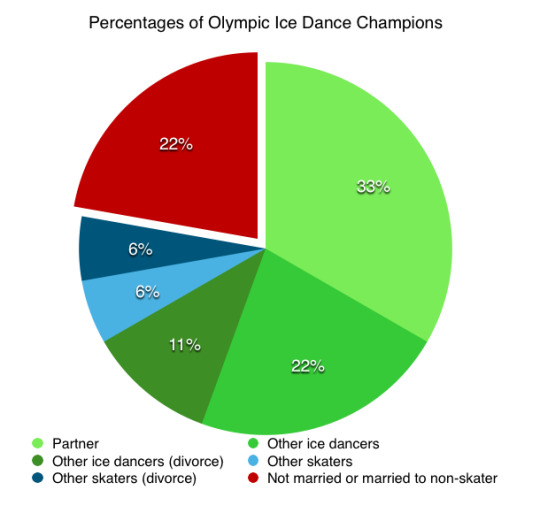
1/3 of other (non-V/M) Olympic Ice Dance champions have married their partners
77.78% of other Olympic Ice Dance Champions went on to marry their partners, or other skaters or ice dancers
This means that other Ice Dance Olympic Champions were over 1.5 times more likely marry a fellow skater than marry a non-skater or not marry at all
Take with this what you will and please share! I spent a long time (over 2 hours) on this!
#virtue moir#olympics#tessa and scott#torvill and dean#tessa virtue#scott moir#Meryl Davis#Charlie White#you’ll notice that none of the ones who have married their partners have divorced#so statistically VM are in the right boat if they...#i mean sjkhskh it’s only statistics what can i say#please say you noticed how i went ‘champions’
131 notes
·
View notes
Photo
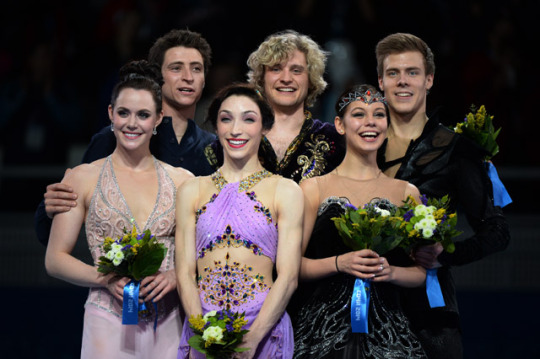


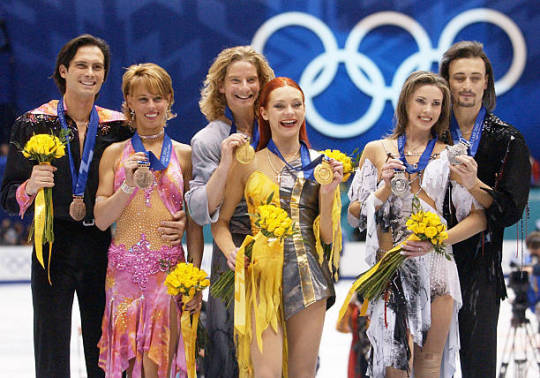

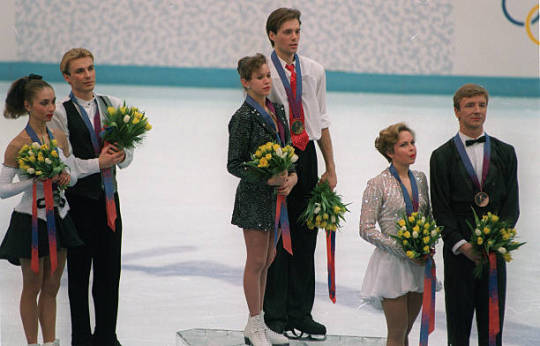


TBT ~ Olympic Ice Dance medalists 1988-2014
2014 1. Meryl Davis & Charlie White (USA) 2. Tessa Virtue & Scott Moir (Canada) 3. Elena Ilinykh & Nikita Katsalapov (Russia)
2010 1. Tessa Virtue & Scott Moir (Canada) 2. Meryl Davis & Charlie White (USA) 3. Oksana Domnina & Maksim Shabalin (Russia)
2006 1. Tatiana Navka & Roman Kostomarov (Russia) 2. Tanith Belbin & Benjamin Agosto (USA) 3. Elena Grushina & Ruslan Goncharov (Ukraine)
2002 1. Marina Anissina & Gwendal Peizerat (France) 2. Irina Lobacheva & Ilia Averbukh (Russia) 3. Barbara Fusar-Poli & Maurizio Margaglio (Italy)
1998 1. Oksana Grishuk & Evgeny Platov (Russia) 2. Anjelika Krylova & Oleg Ovsyannikov (Russia) 3. Marina Anissina & Gwendal Peizerat (France)
1994 1. Oksana Grishuk & Evgeny Platov (Russia) 2. Maya Usova & Alexander Zhulin (Russia) 3. Jayne Torvill & Christopher Dean (Great Britain)
1992 1. Marina Klimova & Sergei Ponomarenko (UnitedTeam) 2. Isabelle Duchesnay & Paul Duchesnay (France) 3. Maya Usova & Alexander Zhulin (United Team)
1988 1. Natalia Bestemianova & Andrei Bukin (USSR) 2. Marina Klimova & Sergei Ponomarenko (USSR) 3. Tracy Wilson & Robert McCall (Canada)
#ice dance#Tessa Virtue#scott moir#Meryl Davis#charlie white#Elena Ilinykh#Nikita Katsalapov#virtue and moir#davis and white#ilinykh and katsalapov#oksana domnina#Maksim Shabalin#Tanith Belbin#benjamin agosto#figure skating#olympics#olympic games#olympic winter games
172 notes
·
View notes
Photo


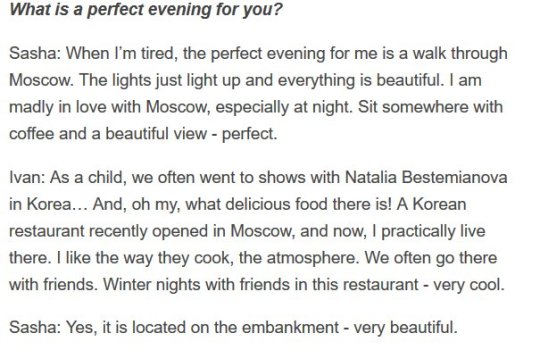

find someone who loves you as much as natalia bestemianova loves alexandra stepanova and ivan bukin
#natalia bestemianova#alexandra stepanova#ivan bukin#figure skating#ice dancing#ice dance#bestis love for them is so next level#she took them to shows in korea when they were kids :')#she was willing to give up her ogm for them to go to olympics#she got olympic champions from all over the world to sign her petition for them#she begged svinin/zhuk to finally let her and andrei help s/b#she yells about them being robbed at every competition#believe me i'm not biased but no one listens to me#iconic#the judging panel should be dismissed sergei ponomarenko is shaking#justice is served after far fetched gpf and nationals results alsdjflasdfj
27 notes
·
View notes
Photo




I rise I rise I rise.
#alina zagitova#still i rise#maya angelou#figure skating#gpf 2018#teamzagitova#pyeongchang 2018#maxim trankov#elena vaitsekhovskaya#tatiana tarasova#natalia bestemianova#poetry#fskateedit
46 notes
·
View notes